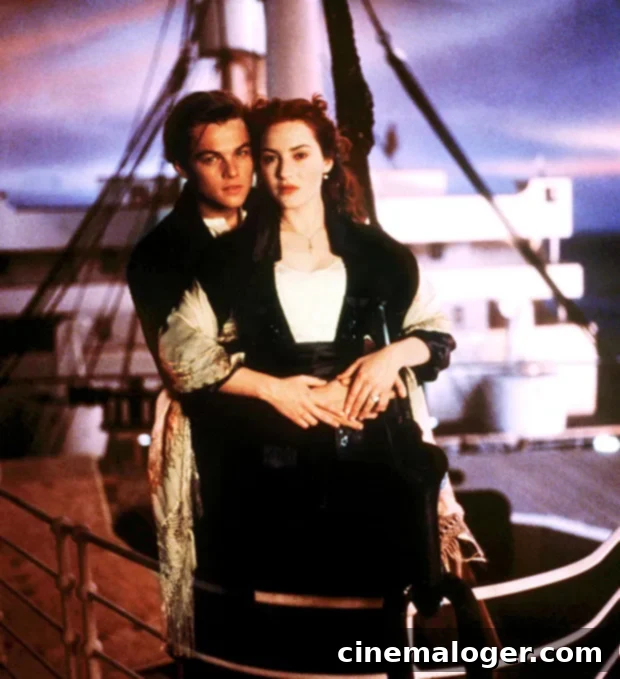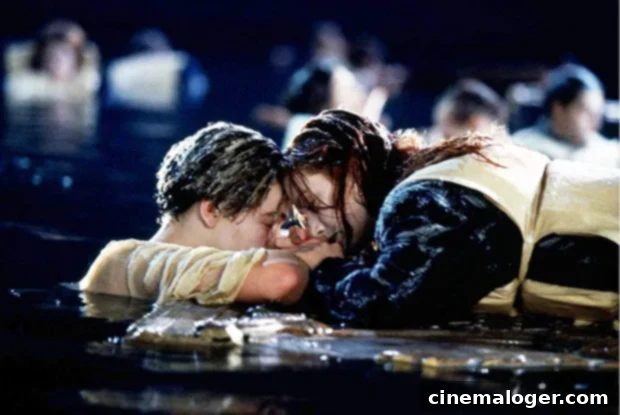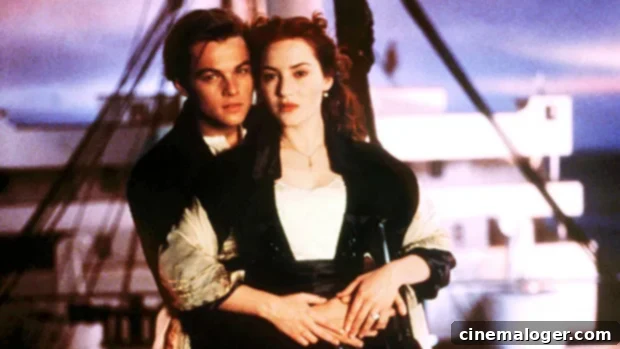Kate Winslet Finally Settles the Age-Old Titanic Door Debate: Could Jack Have Survived?
For a quarter of a century, the final, heart-wrenching moments of James Cameron’s epic masterpiece, Titanic, have sparked one of the most enduring and passionate debates in cinematic history. As the grand ship succumbed to the icy depths of the Atlantic Ocean, millions of viewers watched in agony as Jack Dawson, portrayed by the dashing Leonardo DiCaprio, sacrificed himself for his beloved Rose DeWitt Bukater, played by the incomparable Kate Winslet. Rose famously found refuge on a piece of floating debris – often colloquially referred to as ‘the door’ – while Jack, tragically, remained in the frigid water, eventually succumbing to hypothermia.
The question that has echoed through fan communities, academic discussions, and casual conversations ever since is a simple yet profound one: Could Jack have fit on that floating debris with Rose, and, more importantly, could they both have survived the harrowing conditions? After 25 years of intense speculation, countless fan theories, and even scientific experiments, the woman at the heart of the scene, Kate Winslet herself, has finally offered a definitive answer, weighing in on what many consider to be the ‘biggest movie controversy of all time.’
The Enduring Mystery: Jack and Rose’s Fate
The debate surrounding Jack’s potential survival intensified over the decades, fueled by the sheer emotional power of the film and the apparent visual evidence suggesting there was indeed enough surface area for two adults. Fans have meticulously analyzed frame-by-frame footage, created diagrams, and even conducted buoyancy tests, all in an earnest effort to prove that Jack’s death was, perhaps, an avoidable tragedy. From vibrant online forums and dedicated fan sites to television specials and casual social media discussions, the ‘Titanic door debate’ transcended mere movie trivia, becoming a genuine cultural phenomenon. It stands as a testament to the film’s lasting impact and the deep, personal connection audiences formed with its unforgettable characters.
Even director James Cameron has been asked about it countless times over the years, offering various explanations that often leaned towards the narrative necessity of Jack’s demise rather than purely physical constraints. The persistent questioning highlights how deeply embedded the story of Jack and Rose is in the collective consciousness, leading many to wish for an alternative, happier ending for the iconic pair.
Kate Winslet’s Candid Confession: Finally Setting the Record Straight
Recently, during a candid interview with Joshua Horowitz, Kate Winslet was confronted directly with this very question. Horowitz even showed the 47-year-old actress an old video clip of her co-star, Leonardo DiCaprio, then 48, being pressed on the matter. DiCaprio, known for his playful evasiveness when it comes to the ‘door’ topic, offered a succinct ‘no comment,’ perfectly encapsulating the elusive nature of the answer until now. However, Winslet, now reflecting on a film she made when she was just 21, was ready to address the controversy head-on, providing an insight that has been eagerly awaited by *Titanic* enthusiasts worldwide.
View this post on InstagramA post shared by Josh Horowitz (@joshuahorowitz)
With a refreshing bluntness, Winslet articulated her perspective, expressing a mild frustration with the persistence of the question before diving into a more detailed explanation. “I don’t f***ing know. That’s the answer. I don’t f***ing know,” she initially stated, a response that, while humorous, quickly transitioned into a more practical assessment. “One thing I can tell you. If you put two adults on a standup paddle board, it becomes immediately unstable. I actually don’t believe that we would have survived if we had both gotten on that door. It would not have been a sustainable idea.”

This practical analogy resonated instantly, shifting the focus from mere physical space to the critically important factor of stability and buoyancy. It wasn’t just about whether their bodies *could* fit on the debris, but whether the makeshift raft *could support them both effectively* in the frigid North Atlantic waters without completely submerging them or capsizing. The Oscar winner delivered a definitive answer, noting that now everyone had “heard it here for the first time” directly from her about the *Titanic* door debate. “Yes, he could have fit on that door, but it would not have stayed afloat,” Kate confirmed, offering a nuanced resolution to the long-standing cinematic quandary.
The Physics and Narrative Behind Jack’s Sacrifice
Winslet’s explanation offers a crucial distinction. While acknowledging that there might have been enough surface area for both Jack and Rose, she emphasizes the critical role of stability. In the real world, a flat piece of debris, even if seemingly large enough in terms of dimensions, would struggle significantly to support the combined weight of two adults without becoming completely submerged or uncontrollably capsizing. The issue isn’t simply flotation in the abstract sense, but rather keeping enough of their bodies out of the freezing water to prevent the rapid onset of hypothermia. Even if partially submerged, the constant, direct exposure to near-freezing temperatures would have drastically hastened their demise, rendering their collective survival highly improbable, if not impossible.
This perspective aligns closely with arguments made by various experts and even the film’s creative team over the years. Science-focused programs like *MythBusters* famously tackled the debate, experimenting with various scenarios and concluding that, with some modifications (like attaching Rose’s life vest to the underside of the debris for added buoyancy), two people *could* theoretically stay afloat. However, these experiments often overlooked the dynamic, chaotic nature of the open ocean, the immediate shock of the cold, and the rapid onset of hypothermia – crucial factors that Winslet, having experienced a simulated version on set, implicitly understands from a performance and practical perspective.
Director James Cameron himself has also addressed the ‘door’ multiple times, often reiterating that Jack’s death was a profound narrative imperative. In numerous interviews, Cameron has consistently stated that Jack *had* to die to fulfill the tragic love story’s emotional arc. He wasn’t killed by the ‘door’ itself, but by the overwhelming, catastrophic circumstances – the sinking ship, the unforgiving freezing water, and the severe limitations of their available survival options. The ‘door’ served primarily as a powerful plot device, accentuating Rose’s survival and Jack’s ultimate, selfless sacrifice. “The script says Jack dies. He has to die,” Cameron once remarked, underscoring that the film was never intended to be a factual survival guide, but rather an epic romance set against the backdrop of an unimaginable historical disaster.

Beyond the Door: The Enduring Legacy of Titanic
Kate Winslet’s candid and definitive response effectively puts to rest a quarter-century-long cinematic quandary. While the romantic notion that Jack *could* have survived might forever tantalize audiences, Winslet’s pragmatic explanation reminds us of the harsh, unforgiving realities portrayed in the film. Her nuanced answer addresses both facets of the debate: yes, there was seemingly enough *space* on the debris, but no, it wouldn’t have been a *viable* or *sustainable* means of survival for both individuals in the brutal conditions. Her statement not only clarifies the practical impossibility but also implicitly supports the artistic integrity of the scene, validating the tragic outcome as an unavoidable and essential element of the story, rather than a preventable oversight.
The unwavering fascination with *Titanic* and this particular scene speaks volumes about the film’s extraordinary and enduring impact. Released in 1997, it shattered box office records globally, garnered an astonishing 11 Academy Awards, and captivated a worldwide audience with its unparalleled blend of historical grandeur, breathtaking visuals, and a deeply emotional love story. The characters of Jack and Rose, their whirlwind romance, and their heartbreaking separation have become iconic figures in popular culture, etched into the memories of millions. The ‘door debate’ itself is a profound testament to how deeply invested viewers became in their fates, desperately wishing for a different, happier outcome for the star-crossed lovers. It’s a debate born not of criticism or disdain, but rather of a profound love for the characters and the powerful story that continues to resonate across generations.
Kate Winslet’s Journey: From Titanic to Avatar
Beyond the enduring ‘door’ debate, Kate Winslet’s illustrious career has continued to flourish, leading her back into the visionary world of James Cameron for the highly anticipated *Avatar* sequel, Avatar: The Way of Water. This reunion, taking place two and a half decades after their groundbreaking collaboration on *Titanic*, offered a unique opportunity for Winslet to reflect on the vast changes in filmmaking technology and her own incredible journey as an actress. “You couldn’t compare the two. The two films are so different,” Kate explained in a recent interview with Entertainment Weekly. “Literally, the only common thread is there’s water in both of them, but water that is there for different reasons, behaves in totally different ways. These experiences were so far apart.”
The disparity in their production processes was profound. Winslet vividly recalled, “I turned 21 on that shoot [for *Titanic*]. I am now 47 years old. It’s a very, very, very long time ago.” This significant temporal gap highlights not only the exponential advancement in film technology, particularly in motion capture and immersive underwater performance required for *Avatar: The Way of Water*, but also the immense personal and professional growth experienced by both Winslet and Cameron. “Jim, as a director, as a person, you know, we are just both different, older, have hopefully learned a lot more in terms of how to tell stories and be creative contributors and collaborators,” she added. This evolution from a young actress navigating a massive, challenging historical drama to a seasoned performer embracing groundbreaking cinematic techniques underscores the enduring power and adaptability of their creative partnership, even as their methods and narrative ambitions continue to evolve.
In conclusion, Kate Winslet has finally provided the clarity many *Titanic* fans have yearned for regarding the film’s most persistent question. While the romantic idealism of Jack and Rose both surviving might forever tantalize audiences, Winslet’s pragmatic and definitive statement reminds us of the harsh, undeniable realities portrayed in the film. The ‘door’ was never intended to be a dual-occupancy life raft; instead, it served as the poignant symbol of Rose’s survival and Jack’s ultimate, tragic, and necessary sacrifice – a core emotional element of a story that continues to captivate and emotionally resonate with generations worldwide. The debate may now finally be laid to rest, but the unparalleled legacy of *Titanic* and its unforgettable characters will undoubtedly live on forever in cinematic history.
